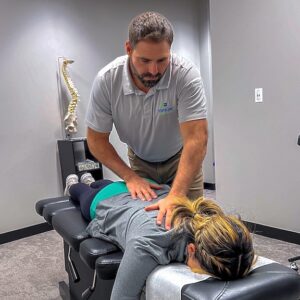Sciatica, with its debilitating pain shooting down the leg, can feel like an unwelcome guest overstaying its welcome. For many seeking relief, the role of chiropractic care in mitigating this discomfort has gained traction. If you’ve been grappling with sciatica, understanding how Chiropractor service Schaumburg plays a pivotal role in offering sustainable, long-term relief could be the beacon of hope you’re seeking.

Understanding Sciatica and Its Impact
Sciatica, far more than just a localized leg pain, manifests as a complex nerve pain that courses from the lower back, often tracing a path from the buttock down the back of the leg. The condition stems from the compression, irritation, or inflammation of the sciatic nerve, which happens to be the body’s longest nerve, extending from the lower back through the hips and down each leg.
Root Causes and Contributing Factors:
Herniated Discs: One of the primary culprits behind sciatica is herniated discs. When the soft inner material of a spinal disc protrudes or leaks through a tear in the tougher exterior, it can impinge on the nearby sciatic nerve roots, triggering pain and discomfort.
Spinal Stenosis: This condition occurs when the spinal canal narrows, putting pressure on the spinal cord and the nerves, including the sciatic nerve. Spinal stenosis can develop due to degenerative changes in the spine, resulting in compression of nerve roots and subsequent sciatic pain.
Misaligned Spine: Even a subtle misalignment of the spine can exert pressure on the sciatic nerve. This misalignment might stem from poor posture, injuries, repetitive stress, or habits that strain the spine, leading to irritation and subsequent sciatica symptoms.
Other Contributing Factors: Beyond these primary causes, sciatica can also be influenced by muscle spasms, tumors, or even pregnancy, which can exert pressure on the sciatic nerve due to the shifting and added weight on the lower back and pelvis.
The Impact of Sciatica on Daily Life:
The effects of sciatica extend far beyond physical discomfort. The persistent, shooting pain originating from the lower back and extending down the leg can significantly impede daily activities and quality of life.
Limitation of Mobility: Individuals grappling with sciatica often experience difficulty walking, standing, or even sitting for prolonged periods due to shooting pain or numbness along the path of the affected nerve.
Disrupted Sleep Patterns: The pain caused by sciatica can disrupt sleep patterns, affecting both falling asleep and staying asleep. This sleep disruption can exacerbate the perception of pain and fatigue.
Impact on Emotional Well-being: Dealing with chronic pain can take a toll on mental health, leading to feelings of frustration, anxiety, and even depression. The constant battle against pain can significantly impact an individual’s emotional well-being and overall outlook on life.
Work and Daily Activities: Sciatica can hinder productivity at work and limit participation in hobbies or physical activities, affecting one’s ability to perform daily tasks effectively.
The Traditional Approach vs. Chiropractic Care
Traditional Approach:
Medication-Centric Management:
The conventional treatment pathway for sciatica heavily relies on medication. It often includes nonsteroidal anti-inflammatory drugs (NSAIDs), muscle relaxants, or, in severe cases, opioid medications. While these drugs aim to manage pain, they often come with potential side effects. Moreover, they offer short-term relief without addressing the underlying cause of sciatica.
These medications might provide temporary comfort by reducing inflammation and numbing the pain signals sent to the brain. However, they don’t resolve the structural issues, such as spinal misalignment or nerve compression, that trigger sciatic nerve pain.
Physical Therapy and Exercise Regimens:
The traditional approach frequently integrates physical therapy involving exercises and stretches aimed at strengthening muscles and improving flexibility. While these exercises can be beneficial for some individuals, they might not effectively target the specific spinal misalignments or nerve compressions causing sciatica. They often focus on symptom management rather than correcting the root cause.
Physical therapy also varies in its effectiveness, as exercises and stretches that may help some patients could potentially exacerbate pain for others, highlighting the need for a more personalized approach.
Invasive Procedures and Surgical Interventions:
In cases where pain persists despite medication and physical therapy, medical professionals might recommend more aggressive treatments. This could include invasive procedures such as epidural steroid injections, nerve blocks, or even surgical interventions like discectomy or laminectomy.
While these procedures can provide relief, they carry risks, including infection, nerve damage, or even worsening symptoms in some instances. Surgery, although sometimes necessary, remains a last resort due to its invasive nature and variable outcomes.
Symptom-Centric Approach:
The traditional medical model tends to focus primarily on managing symptoms rather than addressing the root cause of sciatica. This approach often results in recurring episodes of pain, as it doesn’t resolve the structural or mechanical issues contributing to nerve irritation.
Chiropractic Care:
Holistic Approach with Spinal Adjustments:
Chiropractic care adopts a holistic approach, concentrating on correcting spinal misalignments through adjustments or manipulations. Chiropractors identify and target areas of spinal dysfunction that might be compressing or irritating the sciatic nerve. By realigning the spine, they aim to reduce nerve interference and restore proper function.
Non-Invasive Techniques and Therapies:
Chiropractors utilize non-invasive techniques such as spinal manipulation, mobilization, and soft tissue therapies. These methods aim to address the root cause of sciatica without the need for medications or surgery. By applying gentle pressure and controlled force to the affected areas, chiropractic adjustments seek to restore mobility, alleviate nerve pressure, and facilitate the body’s natural healing process.
Individualized and Comprehensive Care:
Chiropractors design personalized treatment plans tailored to each patient’s unique condition and needs. They consider factors like the patient’s medical history, lifestyle, and specific symptoms to develop comprehensive approaches to sciatica relief. This personalized approach ensures that the treatment aligns with the individual’s body and aims to provide effective and lasting relief.
Preventive Care and Patient Education:
Beyond immediate pain relief, chiropractors emphasize preventive care. They educate patients about proper posture, ergonomics, and specific exercises to help prevent future episodes of sciatica. By empowering patients with knowledge and techniques to maintain spinal health, chiropractors aim to minimize the risk of recurring sciatic nerve pain.
Long-Term Focus on Relief and Wellness:
Chiropractic care differs from the traditional approach by focusing on achieving long-term relief. Rather than just managing symptoms temporarily, chiropractors target the underlying structural issues contributing to sciatica. This focus on addressing the root cause may lead to reduced recurrence of pain and improved overall quality of life for individuals dealing with sciatica.
The Role of Chiropractors in Sciatica Treatment
1. Accurate Diagnosis and Individualized Treatment Plans
Chiropractors begin by conducting a comprehensive assessment to identify the specific cause of sciatic nerve irritation. This involves detailed physical examinations, orthopedic tests, and sometimes imaging studies like X-rays or MRI scans. By pinpointing the precise source of nerve compression, such as a herniated disc or spinal misalignment, chiropractors can create customized treatment plans tailored to each patient’s unique condition, ensuring effective and targeted care.
2. Spinal Adjustments and Manipulation Techniques
Central to chiropractic near me is the use of spinal adjustments, or spinal manipulative therapy (SMT), which involves gentle, controlled force applied to the spine. These adjustments aim to realign vertebrae, improve spinal mobility, and alleviate pressure on the sciatic nerve. Chiropractors use various techniques, including diversified adjustments, flexion-distraction, or instrument-assisted manipulation, to address misalignments and restore proper spinal function, reducing inflammation and pain along the nerve pathway.
3. Addressing Muscle Imbalances and Rehabilitation
Sciatica often results from imbalances in the supporting muscles around the spine. Chiropractors focus not only on the spine but also on the surrounding musculature. They design specific exercise regimens and rehabilitation programs to strengthen weak muscles, improve flexibility, and correct imbalances. These targeted exercises aim to enhance core stability, increase range of motion, and promote proper posture, aiding in the prevention of future sciatic nerve irritation and promoting long-term healing.
4. Patient Education and Lifestyle Modifications
Beyond hands-on treatment, chiropractors emphasize the importance of patient education. They educate individuals about proper posture, ergonomic principles, and lifestyle modifications tailored to their daily routines. This includes advice on ergonomic workstations, proper lifting techniques, and strategies to avoid activities that may exacerbate sciatic nerve pain. By empowering patients with knowledge, chiropractors enable them to actively participate in their recovery and prevent the recurrence of symptoms.
5. Non-Invasive and Drug-Free Approach
Chiropractic care for sciatica offers a non-invasive alternative to surgery and pharmaceutical interventions. Through manual therapies, chiropractors address the root cause of the problem without relying on medications that may carry potential side effects. This approach not only minimizes the risks associated with invasive procedures but also aligns with patients seeking natural, holistic methods of healing.
6. Collaboration and Referrals
Chiropractors often collaborate with other healthcare professionals to ensure comprehensive care for patients with sciatica. They may refer individuals to physical therapists, orthopedic specialists, or pain management experts when necessary, creating a multidisciplinary approach that addresses various facets of sciatic nerve pain. This collaborative effort ensures that patients receive integrated care, maximizing the effectiveness of their treatment plans.
7. Monitoring Progress and Preventative Care
Throughout the treatment process, chiropractors continually monitor and evaluate patients’ progress. They adjust treatment plans based on individual responses to ensure optimal results. Additionally, chiropractors stress the importance of ongoing care and preventive measures, encouraging patients to maintain spinal health through regular check-ups, exercises, and lifestyle modifications. This proactive approach helps prevent future episodes of sciatic pain and promotes sustained wellness.
8. Research and Evidence-Based Practices
Chiropractors are committed to staying abreast of the latest research and evidence-based practices in their field. They integrate proven techniques and innovative approaches into their treatments, ensuring that patients benefit from the most effective and scientifically supported methods available. By adopting evidence-based practices, chiropractors continually refine their approaches, providing patients with the highest standard of care.
Long-Term Relief: The Chiropractic Advantage
One of the notable advantages of chiropractic care in sciatica treatment is its focus on long-term relief. While immediate pain reduction is a primary goal, chiropractors strive to address the root cause of the issue, thereby reducing the likelihood of recurrent sciatic pain.
Studies have shown that chiropractic adjustments can significantly alleviate sciatica symptoms, improve mobility, and enhance the overall quality of life for individuals dealing with this condition. Moreover, the non-invasive nature of chiropractic care makes it an attractive option, particularly for those seeking alternatives to medications or surgery.
Why Choose Us?
Evolve Chiropractic of Schaumburg stands as a beacon of exceptional chiropractic in Schaumburg, offering a comprehensive range of services to elevate your health and well-being. Nestled in the heart of Schaumburg, their team of skilled practitioners is dedicated to providing personalized care that goes beyond mere treatment – it’s about fostering a holistic understanding of your body’s needs. With state-of-the-art facilities and a commitment to patient-centered care, Evolve Chiropractic sets the standard for excellence in Schaumburg’s healthcare landscape. Whether you seek relief from chronic pain or wish to optimize your overall wellness, their tailored approach and cutting-edge techniques ensure a transformative experience, guiding you toward a life of vitality and balance.
1501 Woodfield Rd Ste 117e, Schaumburg, IL 60173
(847) 648-4931
https://myevolvechiropractor.com/locations/chiropractor-in-schaumburg-illinois





